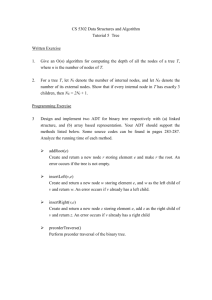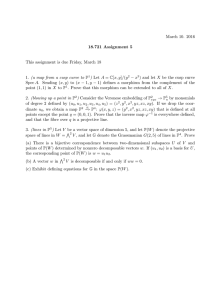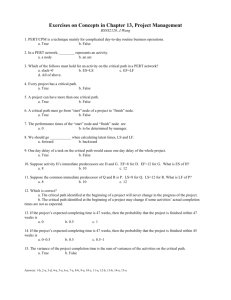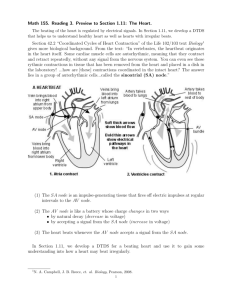IDEAS ON NETWORKS ETC. I HAD WHILE IN PARIS Contents 1. Networks
advertisement
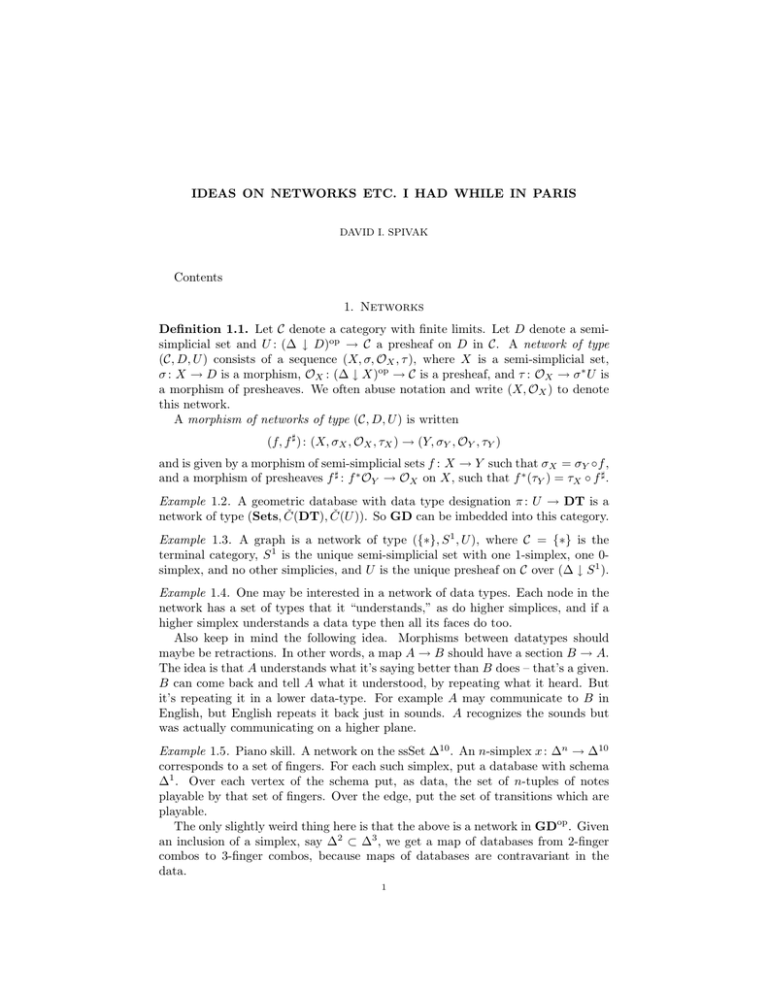
IDEAS ON NETWORKS ETC. I HAD WHILE IN PARIS
DAVID I. SPIVAK
Contents
1. Networks
Definition 1.1. Let C denote a category with finite limits. Let D denote a semisimplicial set and U : (∆ ↓ D)op → C a presheaf on D in C. A network of type
(C, D, U ) consists of a sequence (X, σ, OX , τ ), where X is a semi-simplicial set,
σ : X → D is a morphism, OX : (∆ ↓ X)op → C is a presheaf, and τ : OX → σ ∗ U is
a morphism of presheaves. We often abuse notation and write (X, OX ) to denote
this network.
A morphism of networks of type (C, D, U ) is written
(f, f ] ) : (X, σX , OX , τX ) → (Y, σY , OY , τY )
and is given by a morphism of semi-simplicial sets f : X → Y such that σX = σY ◦f ,
and a morphism of presheaves f ] : f ∗ OY → OX on X, such that f ∗ (τY ) = τX ◦ f ] .
Example 1.2. A geometric database with data type designation π : U → DT is a
network of type (Sets, Č(DT), Č(U )). So GD can be imbedded into this category.
Example 1.3. A graph is a network of type ({∗}, S 1 , U ), where C = {∗} is the
terminal category, S 1 is the unique semi-simplicial set with one 1-simplex, one 0simplex, and no other simplicies, and U is the unique presheaf on C over (∆ ↓ S 1 ).
Example 1.4. One may be interested in a network of data types. Each node in the
network has a set of types that it “understands,” as do higher simplices, and if a
higher simplex understands a data type then all its faces do too.
Also keep in mind the following idea. Morphisms between datatypes should
maybe be retractions. In other words, a map A → B should have a section B → A.
The idea is that A understands what it’s saying better than B does – that’s a given.
B can come back and tell A what it understood, by repeating what it heard. But
it’s repeating it in a lower data-type. For example A may communicate to B in
English, but English repeats it back just in sounds. A recognizes the sounds but
was actually communicating on a higher plane.
Example 1.5. Piano skill. A network on the ssSet ∆10 . An n-simplex x : ∆n → ∆10
corresponds to a set of fingers. For each such simplex, put a database with schema
∆1 . Over each vertex of the schema put, as data, the set of n-tuples of notes
playable by that set of fingers. Over the edge, put the set of transitions which are
playable.
The only slightly weird thing here is that the above is a network in GDop . Given
an inclusion of a simplex, say ∆2 ⊂ ∆3 , we get a map of databases from 2-finger
combos to 3-finger combos, because maps of databases are contravariant in the
data.
1
2
DAVID I. SPIVAK
1.1. Meaning. In a network, a node can speak to a simplex. In so doing, he in
fact speaks to each subsimplex in its language. If x is a face in y then the speech
to x is more refined than that to y. That is, a simplex understands (at best) the
“lowest common denominator” of its faces.
Of course, there may be a sense in which the group “understands” what was said
better than any subsimplex does. This is eventually what I’d like to understand.
2. Learning
2.1. Changing metrics. Jeff Hawkins writes of the phenomenon ”fire together,
wire together.” The idea is that when two neurons fire at the same time, a connection may be formed between them, thus decreasing the “space” between them in
the brain topology.
Here’s a model for doing that mathematically. Suppose that (M, DM ) is a metric
space, x, y ∈ M are two points, and d ≥ 0 is a number, perhaps thought of as being
related to the amount of time between the firing of neurons x and y.
We form a new metric space N having the same underlying set of points as M
does, but with the following metric. For a, b ∈ M , define
DN (a, b) = min{DM (a, b),
DM (a, x) + d + DM (y, b),
DM (a, y) + d + DM (x, b)}.
Clearly, DN (x, y) ≤ d, DN is symmetric, and (if d > 0) DN satisfies DN (a, b) ≥ 0
iff a 6= b. To show that DN satisfies the triangle inequality, one proceeds by cases.
2.2. Query optimization. Higher level structures in the brain ask for information from the lower level structures. Certain queries are performed on lower level
databases more often than others are. The data should be organized to optimize the
speed of these queries. Data should be sorted for the ease of superiors, as predicted
by their past behavior.
2.3. Querying a network. In a network of databases, one would like to query the
network. The network should be able to direct the user’s question to the correct
set of subsimplices who can answer the question. That is a query should descend
through the network hierarchy until it can be answered (or guessed at).
In a democracy, each database (person) gives input as to the answer. In general,
this may not be so.
In general, the query spreads down (and up) the hierarchy, looking for paritial
answers from subordinates and for clarification of the question from the superiors.
What form does an answer take? It seems it could reside at a variety of levels
(a narrative). “More details are needed here, no more are needed there, etc.”
Question 2.1. In a network, can one vertex query another? In whatever theory we
have, how does one node use a common 1-simplex to query another node?
2.4. Changing the topology to make data continuous. It is fundamental
in learning to understand sameness and difference, to understand continuity and
discontinuity. When are two observations part of the same event, and when are
they not?
As data comes in to the observer, the observer decides when data belong together
and when they don’t. There is an effort to produce entities (forms). When data
IDEAS ON NETWORKS ETC. I HAD WHILE IN PARIS
3
comes in, we use its proximity in space and time (and other dimensions) to decide
what is connected and what isn’t. This forms the topology in our mind. Two
perceptions that we deem close should be connected and wired together in our
mind.
Somehow, it would be nice to see a database as giving this. Inside the space of
all possible sections of A × B × C there are some chosen ones, which are deemed to
be “three aspects of the same entity.” Sections of a database are entities; they are
data that appear to be of the same origin. So a database is filled by entities whose
one-ness is established in some way. For example, a person calls a company and is
entered in the database: the call itself establishes the one-ness of the entity being
described (the person), and we get a single section of the data bundle.
But in general, when learning, we want to wire things together in our mind if
they “go together,” i.e. if doing so improves the continuity of the things we see.
We change the topology to fit the data. Can this be made rigorous?
2.5. Model for recognition. Consider the big category of tables Tables+ . Imagine someone is talking to you. You are receiving data in the form of strings (maybe
facial expressions and maybe you have some context lying around). For each string
(sentence, etc.), you can lift that section of the table to various other tables. In
fact, there is a diagram of (tables, lifts) for those data. This is the context category
for that data (sentence).
The main point is: I have a record, or a table of records, of type (C, σ) and I’m
interested in finding lifts of these data
τ
R
w
w
0
w
τ
Γ(C 0 , σ 0 )
w
w
f
/ Γ(C, σ).
Let Con(τ ) be the category whose objects are pairs (f, τ ), liftings as above.
3. Notes from 2008.09.27
In this section I will just write down some ideas I had today.
The goal of the network is to “process information.” Each node has some edges
on it, both input edges and output edges. Some are rays (i.e. edges with no
other endpoint) and some are segments (connecting to another node). Each node
gets information from neighboring nodes and “processes it” or “interprets it.” It is
generally this processed information which is passed on.
Time seems to be important in networks. Information is “processed” and then
later “passed on.” This is just something to keep in mind, because it isn’t purely
categorical.
Is there such a thing as “false information”? I think so. Input information can
somehow be “mis-interpreted” and passed on into the network. I think that it is
really important to know what “false information” is. Characterize it.
I think the process goes something like this. Information can only be transferred
between nodes when the database schema match and some data has been shared
in that schema that is agreed on by both parties.
False information is transfered when the schemas seem to match and the data
seems to match, but “false data” is sent. This data should be detected soon, as
4
DAVID I. SPIVAK
it meshes in with the rest of the node’s database. However it is possible that the
falseness in the data is sufficiently “subtle” to prevent being discovered as false.
The goal of the network is to see patterns in the phenomena presented to the
antennae. Each node is its own network in which every exterior edge is an antenna.
By presenting good information, the antenna helps the network, and by processing
information well, the network somehow helps itself. It helps itself by settling itself
better into the network, being more useful to the larger network (because then the
larger network feeds it better, whatever that may mean). Edges are modified in the
process to strengthen connections to helpful nodes and erode connections to bad
nodes.
4. Notes from 2008.10.01
When a “phenomenon” takes place, nodes communicate their impressions of it
along relevant channels. Perhaps we can identify the phenomenon with the network
communication that it inspires. To do so is to take seriously the “if a tree falls in
the forest” Koan.
Let X be a simplicial set, and let NX = (∆ ↓ X) denote the category of simplicies of X. In this section, we refer to NX as the network associated to X. A
communication system on NX is a functor (fibration?) p : E → NX .
The idea is that a communication is a section of the bundle p. That is, each
node x ∈ NX has a variety of “things it can say,” given by p−1 (x).
A phenomenon consists of a triple (A, f, s), where A is a category, f : A → NX
is a A-shaped diagram in NX , and s : A → f −1 E is a section of the induced bundle
f −1 (p) : f −1 (E) → A.
